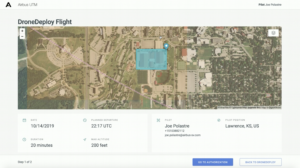
Airbus UTM has been participating in unmanned traffic management (UTM) for more than 2 years, originally as part of the company’s innovation division. They are developing a digital air traffic management solution, and have developed a low altitude authorization and notification capability (LAANC) application. To date, these solutions have been used within the company: but the LAANC capability is now available to the public via a new partnership with leading drone platform DroneDeploy.
“The integration is an important milestone in Airbus UTM’s charter to provide digital traffic services for the evolving aviation ecosystem,” says the company website. “Airbus UTM will integrate its flight briefing service and Low Altitude Authorization and Notification Capability (LAANC) authorization service with DroneDeploy, providing a more seamless experience for commercial drone pilots to plan, review, conduct their flights, and unlock controlled airspace near airports.”
With this partnership, AirbusUTM’s first commercial product becomes immediately significant in the marketplace. The Airbus name is an advantage in the aviation industry. DroneDeploy has an excellent reputation, hundreds of large customers, and many thousands of users: and those users are quickly adopting the DroneDeploy platform as a single end-to-end solution. The combination should provide Airbus UTM with major traction in the enterprise market.
UTM for Drone Operations: Today and Tomorrow
At the DroneDeploy user conference, Airbus Head of UTM Products, Joe Polastre, PhD, introduced the Airbus UTM strategy. “Air Traffic Control is a 30 year old system,” he points out. “It’s clear that a voice-driven system isn’t going to work for drones at the volume that we expect.”
“We want to see thousands of drones flying over a city – and to hit that scale, we need a better solution,” Polastre says . “We’re really interested in how we digitize and make the airspace accessible to everyone.”
LAANC is a first step in the process. Polastre describes the way that LAANC works: companies like Airbus, as UAS Service Suppliers, are required to stay up to date and maintain authoritative data from the FAA with the FAA’s UAS Data Exchange. Requests for authorization to fly in controlled airspace can be granted in almost real time, through applications like the Airbus functionality offered on the DroneDeploy platform.
“The idea is to make this as seamless as possible,” says Polastre. “The FAA wants to make it easy for you to tell them when you are going to be flying near an airport… and they want to be able to promote information sharing.” In the future, Polastre says, LAANC will allow pilots with waivers (such as flight at night) to get authorization to fly.
Polastre says that LAANC is an important part of the process of drone integration into the airspace. LAANC is the first part of UTM that the FAA has operationalized; LAANC also provides a means of communication between stakeholders. “All of us [UAS Service Suppliers] now have a common language to talk about flights – and that’s a first step towards UTM,” says Polastre.
Miriam McNabb is the Editor-in-Chief of DRONELIFE and CEO of JobForDrones, a professional drone services marketplace, and a fascinated observer of the emerging drone industry and the regulatory environment for drones. Miriam has penned over 3,000 articles focused on the commercial drone space and is an international speaker and recognized figure in the industry. Miriam has a degree from the University of Chicago and over 20 years of experience in high tech sales and marketing for new technologies.
For drone industry consulting or writing, Email Miriam.
TWITTER:@spaldingbarker
Subscribe to DroneLife here.